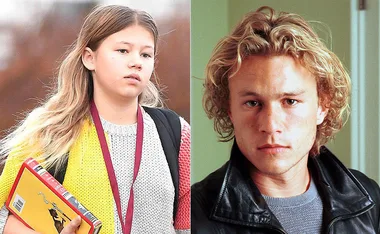“My mother used to say, ‘I wish I could tell you, but it’s too distressing’,” says Janis.
“Ever last year, when she was dying, I said, ‘Don’t take it to the grave, Mum. Whatever it is, tell us, you’ll feel better’, but she would not budge.”
Janis, 64, her sister, Bev, 59, and the rest of the large and loving family now know what that secret was: they’re directly descended from Louisa Collins, a 41-year-old mother of 10 children who was hanged for murder at Sydney’s Darlinghurst Gaol in 1889.
Louisa’s case is astonishing. She as a beautiful woman who was twice married and twice widowed, and she was at various times accused of killing one or both of her husbands. Although hanged for her crime, it’s entirely possible that she was innocent.
The case against Louisa was circumstantial. Nobody ever saw her do it and there was nothing concrete to tie her to the case.
Worst still, some of the key evidence used against Louisa came from her only daughter, May, who was just 10 years old when she was asked to take a Bible in her hand and testify against her mother.
Little May – described in court as pretty and particularly intelligent – told one of the judges she had seen a box of Rough on Rats (essentially pure arsenic) in the kitchen of their home. It wasn’t much, but it was enough to get a conviction.
Louisa protested her innocence all the way to the gallows.
I came across Louisa’s case by chance.
About five years ago, I was working on a different murder trial for The Australian newspaper. There had already been one mistrial, so one of the editors asked me to find out whether anybody had ever been tried more than one for murder.
I had a look in the archives and up came Louisa’s case. She had been tried once, not even twice, but an extraordinary four times for the Crown managed to get a conviction.
The case began to trouble me: how compelling would the evidence against Louisa have been? Who in the annals of English law had ever had to face four trials before being hanged?
I went looking for the original forensic reports, not really believing I would find them.

Yet there they were, stored in an old and dusty box at NSW State Records, which is a cool building under the gum trees in a lovely paddock more than an hour from Sydney.
Some of those records were more than 120 years old, but had been preserved, as had some of Louisa’s letters from jail, in which she begged for her life.
From there, I went looking for records from the old Supreme Court, for whatever notes had been taken by police and for original statements from witnesses who lived in Louisa’s street.
Some of the evidence was strongly suggestive of Louisa’s guilt, but I had doubts.
The case was full of strange tics and annoying coincidences. Before long, some of the characters, including the ghastly hangman, began to haunt my dreams.
After five years obsessing about the case, I took the results to HarperCollins, who agreed to publish Last Woman Hanged, the first full-length examination of the case, so readers could make up their own minds. Yet before I could publish the book, there was one more thing I needed to do – track down Louisa’s descendants.
I didn’t know where any of them had ended up, or whether there were any of them alive, but I knew I couldn’t in good conscience publish a book about Louisa without trying to find them. I also knew readers would want to know what happened to Little May, after she had been made to take the stand.
The task of tracing Louisa’s family tree was at times deeply frustrating. There were so many red herrings and dead ends.
I knew from searching the archive at the NSW Registry of Births, Deaths and Marriages that Louisa had given birth to 10 children, seven of whom were still living when she died. What had happened to them?
A report from a 120-year-old copy of The Sydney Morning Herald suggested that three of Louisa’s children, all with the last name Andrews, were allowed to see her on the evening before she died, so they – and she – could say goodbye. Her eldest son, Herbert, who was in his 20s, took May and another son, Frederick, to Louisa’s cell in
Darlinghurst Gaol, where they all wept and prayed.
In the days after the execution, Herbert and Frederick went north to Adamstown, near Newcastle, where Herbert found work as a butcher. A search of the records turned up an old certificate that showed he married his sweetheart, Annie Henry, in Adamstown in 1893.
According to state archives, Herbert and Annie had three children: Frederick was born in 1897, but he lived for just two years. They had better luck with their daughters: Mabel and Pearl survived their childhoods, but then married and changed their names.
One of the biggest stumbling blocks when researching a family tree is that Australian women, upon getting married, almost always change their names. From then on, their children appear in the records under their father’s name. Some digging through The Newcastle Herald turned up the fact that Mabel had married Tom Civill in
1918 and had a son, Douglas Civill. He had gone on to have two boys, twins Howard and Arthur.
Howard Civill died a few years ago, but a search of the White Pages turned up the fact that Arthur Civill – Louisa’s great-great-grandson – was alive and living in the Newcastle area.
The temptation was to immediately call him, but how much did he know about his family history? Had anyone ever told him his great-great-grandmother , Louisa, had been hanged for murder at Darlinghurst Gaol?
I nervously called, introduced myself and asked, “Mr Civill, has anyone ever talked to you about your family history?”
“No,” he said, “I can’t say they have. Why do you ask?”
“Would you mind if I wrote you a letter?” I said, coming over all shy.
“A letter?” he said, “I suppose that would be alright.”
So I wrote it all down and then I waited, wondering what Arthur would think. By chance, I was in Queensland visiting my own family when he telephoned.
I braced myself, thinking, now he’s going to say, “We don’t really want to be connected to this story”, but happily, wonderfully, he said, “You’ve certainly got
everyone talking, haven’t you?”
I was so relieved. We laughed and talked about the case, and then Arthur dropped a bombshell.
“Now, you won’t believe what I’ve got in front of me. It’s an old family photo of Herbert Andrews. Would you like to see it?”
Would I like to see it? Oh yes, I would love to see it!
“I’ll see if we can’t get a nice copy,” Arthur said.

Less than a week later, a copy of that photograph landed on my desk at The Australian Women’s Weekly and I couldn’t stop looking at it. There was Herbert, son of
Louisa Collins, all grown up with his wife, Annie, and their two beautiful daughters, Mabel and Pearl, dressed prettily in white dresses.
“I have strong memories of those two ladies,” Arthur said, “I spent a great deal of time with them when I was a boy, but I had no idea about Louisa. I suppose it was the kind of thing people used to cover up, like having a convict in the family. I remember Aunty Pearl saying a few things and I wonder if she knew, but as children, we
were never told.”
Arthur has now read Last Woman Hanged and “it was like a pendulum for me, thinking, at first, she’s guilty and then she’s not guilty. But, to have four trials, that’s not justice. The last jury, I think they just gave up and gave everyone the verdict they wanted.”
His wife, Barbara agrees, “To think they put that little girl on the stand to testify against her mother… I suppose things were very different in those days, but it seems very cruel.”
Like everyone, Arthur was curious about what had happened to Louisa’s other children and to May in particular. The search had proved frustrating.
The newspaper archives had turned up one article, dated Saturday, January 12, 1889 – that is, just four days after Louisa was hanged – in the old *Richmond and
Windsor Gazette*, which said, “We understand that Mr James Geehan and his good wife has determined upon adopting the little girl, May Andrews, daughter of Louisa Collins. The child is pretty and intelligent, and Mr and Mrs Geehan are to be compliments on (their) kindness of heart…”
May had been adopted out, in other words. I didn’t doubt the accuracy of that story. The Geehans lived at Freemans Reach and the Richmond and Windsor Gazette had carried a number of stories of the family over the years, including the fact that nine of their 10 children had died before they adopted May, but what happened from there?
I searched all the available records, even checking with the Catholic Church to see if May had perhaps become a nun – but I kept hitting a brick wall. I knew May might have changed her name from Andrews to Geehan, but there was no record of either a May Andrews or a May Geehan getting married, or having a baby.
There was nothing to suggest that she had died, so I was stumped. How could a little girl simply just disappear?
Then, from an old court report dated 1894, came this, “On the 3rd of April, Beatrice Tierney did beat and assault Mabel Andrews at Freemans Reach… Mabel deposed that she resided with Mrs Geehan at Freemans Reach; on the 3rd of April, [the] defendant came to the yard of Mrs Geehan’s… and beat her on the face with both hands, blackening both eyes…”
So May had changed her name to Mabel Andrews. That made things easier. I began my search again and discovered that as soon as May – or Mabel – tuned 18, she moved away from Freemans Reach to be closer to Herbert and, in 1898, she married a fettler on the railways, John McGuiness, and begun having his children.
The first of them was a little girl. Achingly, May called that child Alice Louisa. She also had a boy, Edward, but tragically, both Alice and Edward (and possibly a third child, John) died when they were infants, leaving May with no living children until 1909, when she gave birth to another daughter, Thelma.
It would have been lovely to leave the story there, with May happily married, the mother of a healthy little girl, but I knew I would have to keep going.
What, ultimately, happened to her and her daughter?
I searched for a year, finding no trace of any other descendants.
Then, in July 2013, just as I was preparing to write the final draft of Last Woman Hanged, a death notice appeared in The Newcastle Herald, giving me all the information I needed.
Thelma had grown up and married, and there were descendants. Some were called Cairney and some were called Thompson.
They were inviting people to attend a wake for Mabel Thompson, Louisa’s great-granddaughter, and so I contacted Pettigrew Family Funerals in Newcastle and they agreed to pass a message onto the family.
It was Janis who got in touch and I’ll treasure her letter forever.
“Dear Caroline, firstly, let me thank you for tracking us down… it’s very exciting to finally read some background on the history of our dear grandmother [Louisa’s granddaughter, Thelma], who was much loved by us all.”
“I’ve shared this story with our Aunty Margaret and her younger brother, Victor. They had no knowledge of Louisa, but I’m not so sure about my own mother. She once told us she knew a family secret, but wouldn’t share it with us because it was too distressing. Even in her later years, she wouldn’t tell us and I can’t help but wonder
if Louisa was indeed the secret… You have created great excitement in our family so it would give us enormous pleasure to meet some more of Louisa’s descendants.”

Caroline Overington’s book on the story.
And so, The Australian Women’s Weekly invited Louisa’s descendants – the Thompsons, Cairneys and Civills – to lunch in Newcastle so they could finally meet each other.
No words can describe the moment they all came piling through the door. There was no awkwardness.
On the contrary, there were hugs and tears.
By the end of the lunch, it was like they had known each other for 100 year – which, in a way, they had. All were related and yet knew nothing about their fascinating family history.
Hours went by in what seemed like minutes, as three families shared their stories. The Australian Women’s Weekly team stood back as much as possible, to allow everyone time to come to terms with their emotions.
From the outside looking in, what was most apparent was how far the Andrews family had come. Just over a century has passed since young Herbert departed Louisa’s cell, knowing she would be hanged. Hundreds of women protested the execution, but their plea for mercy had fallen on deaf ears and there was no longer anything that Herbert or anyone else could do to stop the hanging.
Herbert and his brother went North to Newcastle, probably on horseback and with no more than his swag and the tools to light a fire to keep them warm at night.
They returned to work: Herbert qualified as a butcher and Frederick worked as a miner. Herbert also built his own house in Newcastle, by hand.
0As tough as it must have been surviving the loss of their parents – one apparently murdered, the other hanged for the crime – there were moments of great joy.
Herbert married and had children, and so did May, and the family stayed tight in those years after their mother was executed, working hard and supporting one another into the new century.
All knew the secret, but kept it from their children, choosing to forge on, as they determined to make life easier for generations to come.
Four generations on, Louisa’s descendants stood proudly for these photographs, celebrating the lives of their shared ancestors and the rich and fulfilling lives they made for themselves.
“The emotion of this day will never leave me. I feel that the gaps in my past have been filled,” said Vic Cairney, 69.
“My grandmother was a lovely woman, a joy, but there was a sadness in her sometimes and I never knew why.
“This helped me put a picture together and I feel more complete. The women in my family tree, they were wiped from the history books, but they are home now and we can honour them.”

.png?resize=380%2C285)









